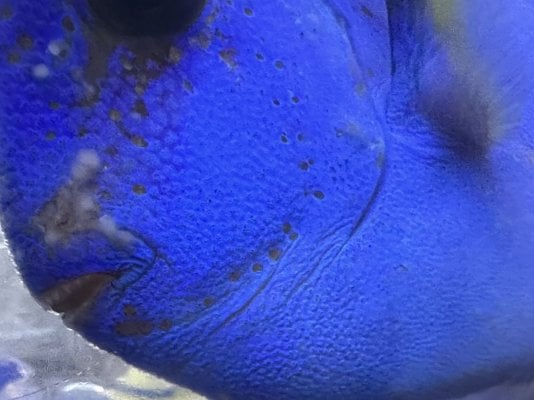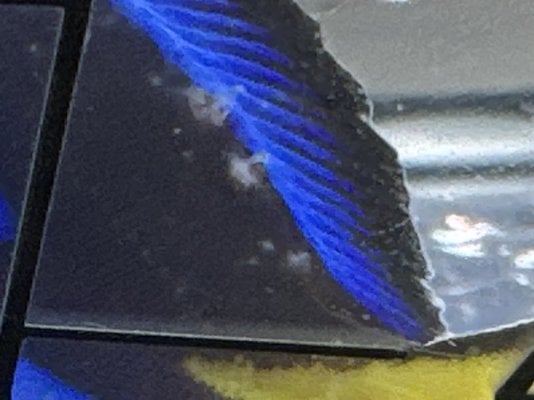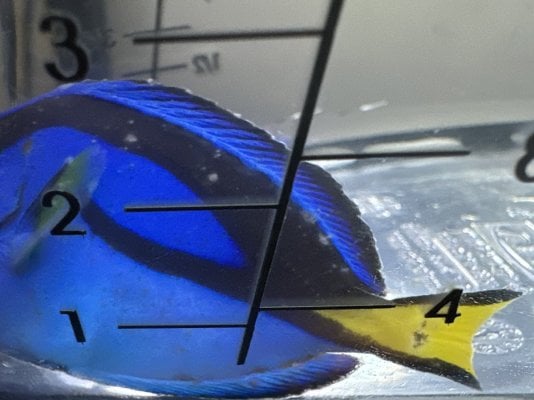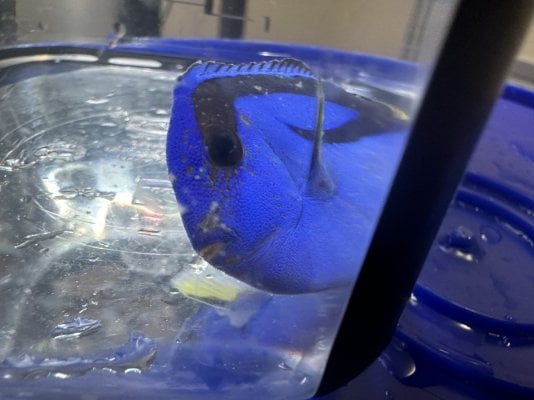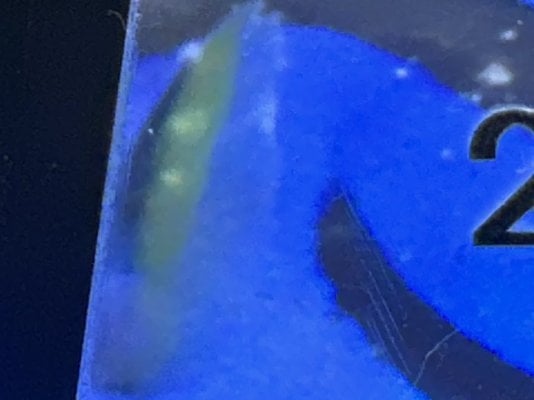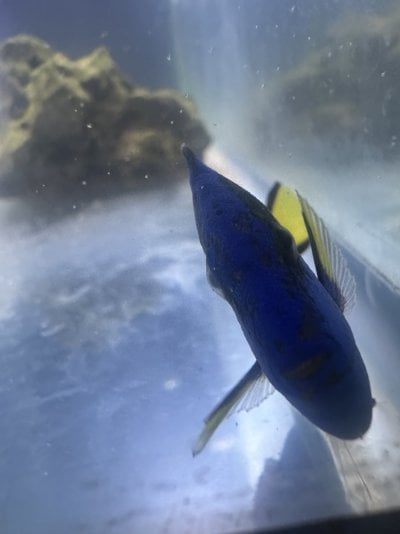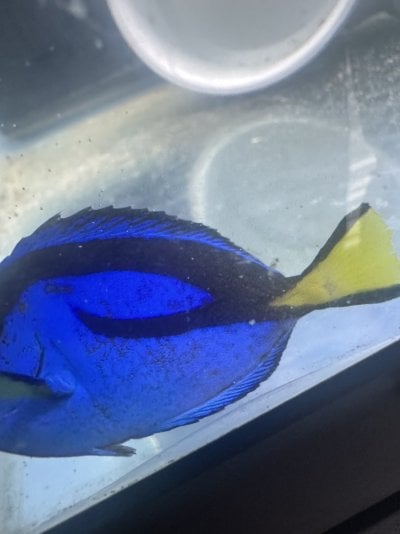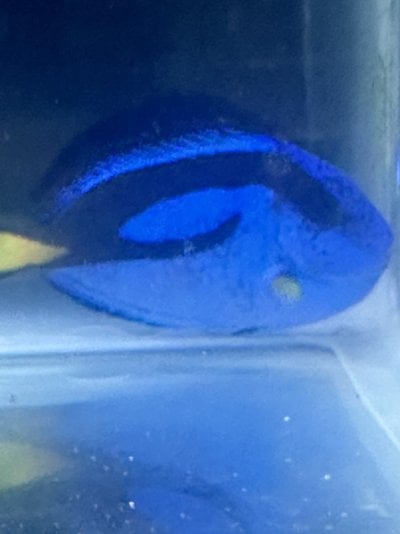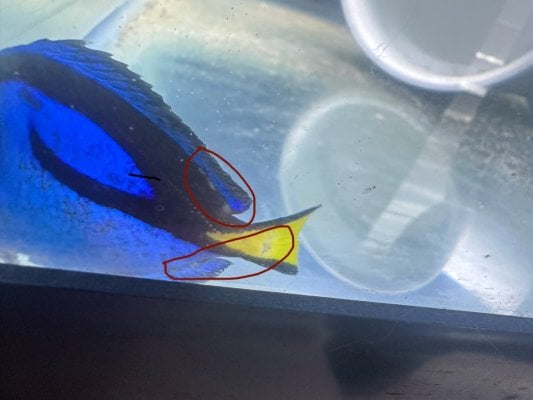Thanks, I’ll keep an eye out for any parasite problems with my two clowns but they look as good as the day I got them so I’m staying hopeful.Sorry for your two losses.
Two at once, and both loss?
Maybe keep a close eye on possible parasite infection to be safe.
Navigation
Install the app
How to install the app on iOS
Follow along with the video below to see how to install our site as a web app on your home screen.
Note: This feature may not be available in some browsers.
More options
You are using an out of date browser. It may not display this or other websites correctly.
You should upgrade or use an alternative browser.
You should upgrade or use an alternative browser.
Scales missing on flame back angel
- Thread starter AlexT0599
- Start date
- Tagged users None
Thanks, I’m going to double check my water parameters but every time it’s come back normal. I definitely need to invest in a better way to check other than the API. Any suggestions?PS - sorry to hear
For fish only you need to check.Thanks, I’m going to double check my water parameters but every time it’s come back normal. I definitely need to invest in a better way to check other than the API. Any suggestions?
Check salinity daily with refractometer to 1.023. Use an Auto Top Off to keep that measure solid. When salinity is off, everything is off.
check nitrate and phosphate weekly to ensure they are not either rising or falling on a consistent basis. Smooth nitrate tests work well as the colour change is easy to see. Phosphate colour change is very hard to determine so in this case, I use the Hanna phosphorus UL checker to get a relative number.
If they constantly rise, you need to export more wastes. If constantly falling you can always bump them with manual dose.
Sorry for your loss. I am just seeing this post now. Your first pics were clear signs of a bacterial lesion. I've seen thousands of these and they can come from many vectors in and enclosed environment. Since the royal gramma has also passed, Id say the original cause was a ciliate possibly Urinoma as some have suggested. These will quickly multiply eating the epidermal tissues allowing bacterial to eventually take hold and create a septic condition. Very hard to kill on small animals once established because these ciliates are somewhat protected by the fishes own slime layer. In larger animals I've found that formalin with extended immersion protocols to be the best option. I am not sure how easy formalin is the get now.
Urinoma is spread by fish to fish contact. Keep and eye on your other inhabitants and if you see lesions or ocelli developing, I'd remove them and start and bacterial and parasitic bath ASAP.
Urinoma is spread by fish to fish contact. Keep and eye on your other inhabitants and if you see lesions or ocelli developing, I'd remove them and start and bacterial and parasitic bath ASAP.
Also, remember the behavior of you lost animals. The angel (hiding, irregular swimming, laying down) all signs of what happens to a septic animal. Remember it is the secondary bacterial infection that generally kills fish.
I have always used API....Thanks, I’m going to double check my water parameters but every time it’s come back normal. I definitely need to invest in a better way to check other than the API. Any suggestions?
my royal gramma unfortunately didn’t make it either, but I never noticed anything wrong physically until I found him this morning. I thought it was all one sided. But I found him like this when I woke up any ideas as to why his scales are now missing or maybe I just missed the spots when I inspected him?
When I found him my cleaner shrimp was some what aggressively cleaning his gills, maybe it was something in his gills?
I checked his mouth and everything looked fine so im not sure
Sorry to hear.
Well darn, we can't blame the gramma now.
Do you have a microscope by chance? A quick skin scrape can tell if this is Uronema or not. Another trick is to give the freshly deceased fish a 10 minute FW dip and look for flukes. You'd still need at least a hand lens to see the smaller types of flukes though.
I apologize - I disagree with a couple of these comments. 1. The scale damage could have just been 'scale damage' from physical injury - as compared to infection. 2. As many people here said - there could have been an infection on top of an injury. 3. Uronema does not tend to be infective fish to fish in the same way Ich or velvet is. Thus, I don't see any reason to do anything differently now (even if its Uronema) since normal tanks with no ill fish can have uronema present when tested for. 4. Since there is no real proof or clear suggestion of uronema (IMHO) - and since Uronema is not usually spread from fish to fish contact - I would not be watching for symptoms of uronema, but instead breathing issues, more spots, scratching, etc. In fact - I would consider just performing a fallow period on your display tank (8 weeks) - and treat your remaining fish with standard QT methods (unless they have already been through a copper/prazipro protocol - sorry - don't remember if this has happenedSorry for your loss. I am just seeing this post now. Your first pics were clear signs of a bacterial lesion. I've seen thousands of these and they can come from many vectors in and enclosed environment. Since the royal gramma has also passed, Id say the original cause was a ciliate possibly Urinoma as some have suggested. These will quickly multiply eating the epidermal tissues allowing bacterial to eventually take hold and create a septic condition. Very hard to kill on small animals once established because these ciliates are somewhat protected by the fishes own slime layer. In larger animals I've found that formalin with extended immersion protocols to be the best option. I am not sure how easy formalin is the get now.
Urinoma is spread by fish to fish contact. Keep and eye on your other inhabitants and if you see lesions or ocelli developing, I'd remove them and start and bacterial and parasitic bath ASAP.
According to my tests my nitrate is within the 0-5 ppm and my ammonia is 0 ppm, nitrite is 0 ppm and my PH is 7.8For fish only you need to check.
Check salinity daily with refractometer to 1.023. Use an Auto Top Off to keep that measure solid. When salinity is off, everything is off.
check nitrate and phosphate weekly to ensure they are not either rising or falling on a consistent basis. Smooth nitrate tests work well as the colour change is easy to see. Phosphate colour change is very hard to determine so in this case, I use the Hanna phosphorus UL checker to get a relative number.
If they constantly rise, you need to export more wastes. If constantly falling you can always bump them with manual dose.
the only other fish I have in my DT are 2 clowns who still look very healthy, but in QT I have a Blue hippo tang who is currently being treated for a fungal infection and HLLE which she developed after having her in copper for a prior fungal infection. But the infection she has is very different she popped up with grey bumps and also white spots. She is being treated in Fritz copper safe, Metro +, and as of today melafix.Sorry for your loss. I am just seeing this post now. Your first pics were clear signs of a bacterial lesion. I've seen thousands of these and they can come from many vectors in and enclosed environment. Since the royal gramma has also passed, Id say the original cause was a ciliate possibly Urinoma as some have suggested. These will quickly multiply eating the epidermal tissues allowing bacterial to eventually take hold and create a septic condition. Very hard to kill on small animals once established because these ciliates are somewhat protected by the fishes own slime layer. In larger animals I've found that formalin with extended immersion protocols to be the best option. I am not sure how easy formalin is the get now.
Urinoma is spread by fish to fish contact. Keep and eye on your other inhabitants and if you see lesions or ocelli developing, I'd remove them and start and bacterial and parasitic bath ASAP.
Last edited:
No it hasn’t gone through a fallow period, however I don’t really have the room to remove my ocellaris clowns unless they can be treated in Fritz copper safe, metro + and melafix along side my blue hippo, would they be alright being treated in those as well?I apologize - I disagree with a couple of these comments. 1. The scale damage could have just been 'scale damage' from physical injury - as compared to infection. 2. As many people here said - there could have been an infection on top of an injury. 3. Uronema does not tend to be infective fish to fish in the same way Ich or velvet is. Thus, I don't see any reason to do anything differently now (even if its Uronema) since normal tanks with no ill fish can have uronema present when tested for. 4. Since there is no real proof or clear suggestion of uronema (IMHO) - and since Uronema is not usually spread from fish to fish contact - I would not be watching for symptoms of uronema, but instead breathing issues, more spots, scratching, etc. In fact - I would consider just performing a fallow period on your display tank (8 weeks) - and treat your remaining fish with standard QT methods (unless they have already been through a copper/prazipro protocol - sorry - don't remember if this has happened
Why are you treating with metro or melafix?No it hasn’t gone through a fallow period, however I don’t really have the room to remove my ocellaris clowns unless they can be treated in Fritz copper safe, metro + and melafix along side my blue hippo, would they be alright being treated in those as well?
I was told by a few people at my LFS that metro and melafix will help.Why are you treating with metro or melafix?
Will help what? I mean - Metronidazole can help certain diseases, melafix is supposed to help certain diseases (though there is a fair bit of debate here). Copper of course is used against various protozoans. It is a good idea to have a diagnosis (or at least a really good idea at one) - IME, before mixing drugs and treatments. - and the treatments themselves can be toxic. In other words - it would be fine to fallow your tank by putting your clowns in copper - again I would not personally add metronidazole. It would be nice to see the fungal infection on the tang (copper does not treat this, per se, neither does metronidazole - nor do either help with HLLE). I don't know why copper + Melafix would be ok for the tang, but not the clowns?I was told by a few people at my LFS that metro and melafix will help.
The problem is - let's say your clowns are carrying a parasite - but are not showing symptoms. Once you place new fish in the display tank, you may have an outbreak - which is why after an issue like this its sometimes better to start over and QT all of your fish and leave your tank fallow. Note - If this represents Uronema - I do not believe you will be able to 'cure it' with medications.
I am treating
I’m treating with metro and melafix because my tang developed HLLE and after telling the people at my LFS that the metro wasn’t working they told me to try both and see if that helps. And then she’s also in copper just in case the “fungal” infection was actually an external parasite because no one on my post could really come up with a direct answer as to wether it was fungal or and external. She was on sulfaplex and copper however when I started treating her for the HLLE I stopped treating with sulfaplex.Will help what? I mean - Metronidazole can help certain diseases, melafix is supposed to help certain diseases (though there is a fair bit of debate here). Copper of course is used against various protozoans. It is a good idea to have a diagnosis (or at least a really good idea at one) - IME, before mixing drugs and treatments. - and the treatments themselves can be toxic. In other words - it would be fine to fallow your tank by putting your clowns in copper - again I would not personally add metronidazole. It would be nice to see the fungal infection on the tang (copper does not treat this, per se, neither does metronidazole - nor do either help with HLLE). I don't know why copper + Melafix would be ok for the tang, but not the clowns?
The problem is - let's say your clowns are carrying a parasite - but are not showing symptoms. Once you place new fish in the display tank, you may have an outbreak - which is why after an issue like this its sometimes better to start over and QT all of your fish and leave your tank fallow. Note - If this represents Uronema - I do not believe you will be able to 'cure it' with medications.
Theses are the pics of the tang in question. This all popped up after adding the royal gramma.
Attachments
Just FWIW, HLLE is not treatable per se with medication. Not all of the lesions on your tank look like HLLE. This could be injury, mucus cones, etc. Does your tang have any other symptoms - do the spots change position? Lets see if @Jay Hemdal has any ideas
The white spots are gone and now she just has these dark spots and these almost dark veiny looking spot on her stomach. I’ve had her in QT for weeks now and she’s honestly kinda looking worse so I’m not sure what else I can do. But other than the way she is looking she seems fine, she does hide behind the filter a lot but I figure that’s because she doesn’t have too many good spots to hide. This is how she looks now. Any input on how to help her is very appreciated.
Attachments
Not all diseases can be diagnosed from photographs, and fish can have multiple issues.The white spots are gone and now she just has these dark spots and these almost dark veiny looking spot on her stomach. I’ve had her in QT for weeks now and she’s honestly kinda looking worse so I’m not sure what else I can do. But other than the way she is looking she seems fine, she does hide behind the filter a lot but I figure that’s because she doesn’t have too many good spots to hide. This is how she looks now. Any input on how to help her is very appreciated.
What I see on the blue tang are some enlarged skin pores, that is a symptom of HLLE. Further back on the fish I see some diffuse white patches and some larger white spots. Those are likely mucus produced as a reaction to some stress. I can also see some smaller white spots that I can’t rule out as being ich.
External fungal infections are very rare in marine fish, I’ve only seen a few cases.
the White spots are on the glass or just air bubbles she is currently free of white spots however she does have these spots circled in the picture, (the small white looking spots in the picture are just air bubbles) . Any suggestions on how to help get rid of the HLLE?Not all diseases can be diagnosed from photographs, and fish can have multiple issues.
What I see on the blue tang are some enlarged skin pores, that is a symptom of HLLE. Further back on the fish I see some diffuse white patches and some larger white spots. Those are likely mucus produced as a reaction to some stress. I can also see some smaller white spots that I can’t rule out as being ich.
External fungal infections are very rare in marine fish, I’ve only seen a few cases.
Attachments
HLLE is usually not treatable, but you’ll hear dozens of things to try. Avoid using dusty carbon and feed the fish a varied diet.the White spots are on the glass or just air bubbles she is currently free of white spots however she does have these spots circled in the picture, (the small white looking spots in the picture are just air bubbles) . Any suggestions on how to help get rid of the HLLE?
The white splotches don’t look to serious to me, just watch to see if they enlarge or spread. Otherwise, I think they are just mucus.
Similar threads
- Replies
- 45
- Views
- 678
- Replies
- 10
- Views
- 339
- Replies
- 9
- Views
- 64








